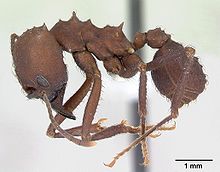| Acromyrmex balzani | |
|---|---|
 | |
| Profile view of an A. balzani worker | |
| Scientific classification | |
| Domain: | Eukaryota |
| Kingdom: | Animalia |
| Phylum: | Arthropoda |
| Class: | Insecta |
| Order: | Hymenoptera |
| Family: | Formicidae |
| Subfamily: | Myrmicinae |
| Genus: | Acromyrmex |
| Species: | A. balzani |
| Binomial name | |
| Acromyrmex balzani | |
| Synonyms | |
Acromyrmex balzani is a species of leaf-cutter ant of the subfamily Myrmicinae. It is found Argentina, Paraguay, and Brazil. [1] It occurs in Cerrado [1] [2] and semideciduous seasonal forest. [1] It is a grass-cutting species. [2]

